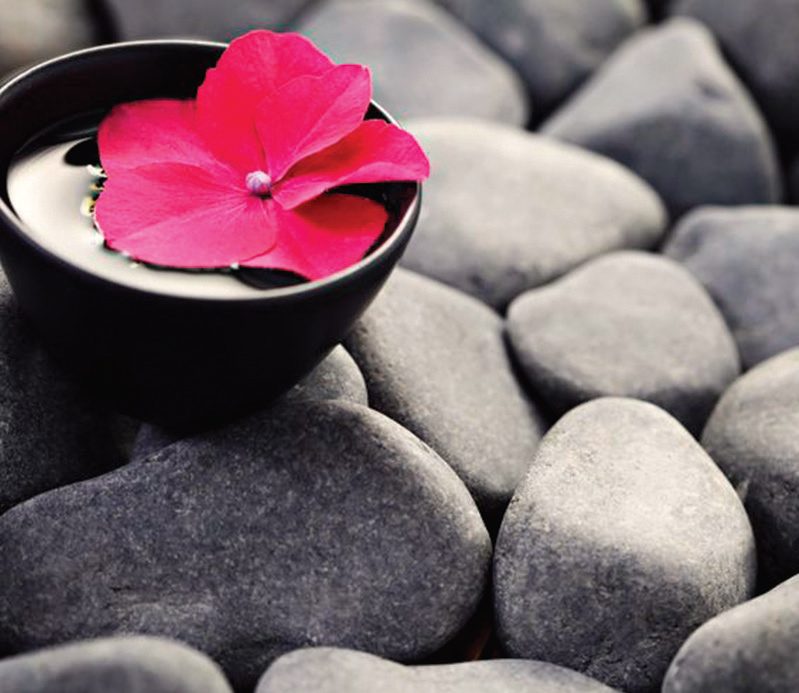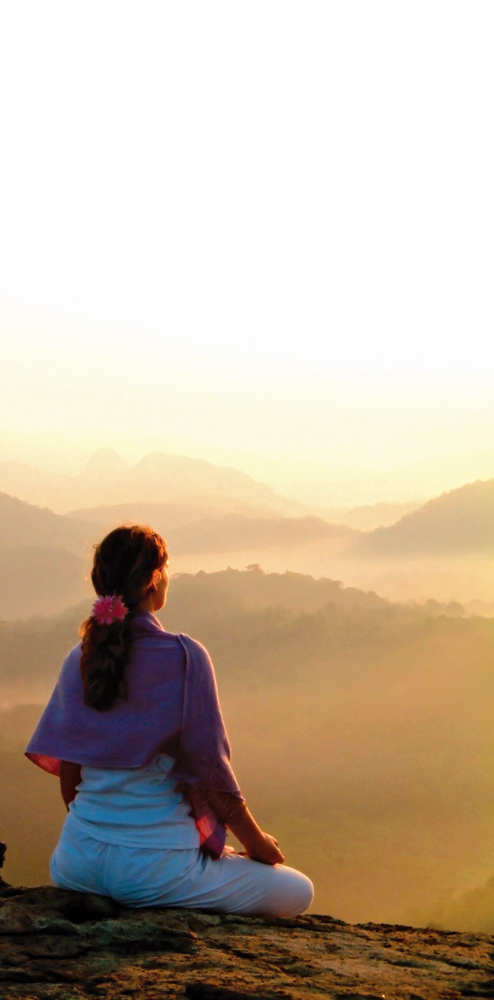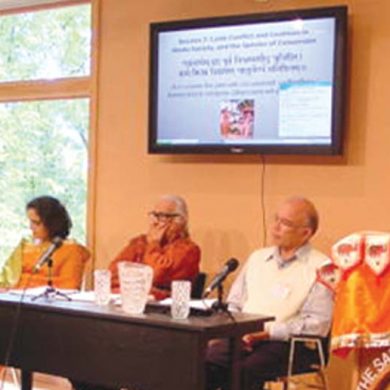Pranayama is a very deep but often misunderstood aspect of yoga. From ordinary breathing practices to yogic mastery of the vital force and promoting the higher energy of consciousness, it all relates to Pranayama at various levels. In the following article, we will explore the deeper aspects of Prana and Pranayama, including how to achieve a unitary prana beyond the fluctuations of the ordinary breath, senses and mind.

In many classical Sanskrit texts, the term yoga is used primarily for pranic practices, while the term jnana or knowledge is used for meditation. this is reflected in the teachings of ramana maharshi, who uses these terms in this manner. many yoga Shastras and yoga Upanishads explain prana and the related factors of Pranayama, chakras and nadis in great detail. Sometimes the term Hatha Yoga is used for this pranic yoga and Raja Yoga for the yoga of meditation. So yoga and Pranayama are closely related and sometimes equated.

Yoga is not just control of the mind but also control of the prana, which go together. mind and prana are often said to be like the two wings of a bird, with the mind as the power of knowledge and the prana as the power of action. Both always move and act in accord with each other. yet prana has deeper meanings as well.
Prana: levels of meaning
Prana is a word, much like yoga, that has a broad range of indications and several different but interrelated levels of application. you may be surprised to find that prana can mean much more than what you may have already thought it to be. these different meanings are not contradictory but complementary. they help us bridge the gap between our ordinary breath and the highest energy of universal consciousness.
Prana in the higher sense is the spirit, the awareness that inhabits the body and mind, but transcends them. this higher prana is much more than the physical breath. it is the great Prana, Mahan Prana, which is synonymous with the energy of consciousness, Chit-Shakti. this is the non- elemental, unmanifest prana of the immortal life. it is inherent in the eternal being or sat, not the result of any biological processes.
Pranic-based yoga practices aim to access this supreme prana, though it is a process that can only occur by degrees, often starting at a physical level. But we should always remember that immortal prana as our ultimate goal of Pranayama practice. this is the Prana Purusha of the Upanishads, the Supreme Self, whose nature is the highest life energy beyond birth and death.
Prana can indicate the cosmic creative force, the Ishvara, or Cosmic lord, such as we find in the yoga Sutras. this is the energy that creates, sustains and dissolves the universe. Our own individual soul or Jivatman can also be referred to by prana. Jiva, or the soul, means prana or life. this prana of the soul is what allows us to take various births and to ultimately transcend the process of birth and death.
Prana and breath
Prana is a cosmic force and pervades all of life and nature. Prana is not simply oxygen, which is but a carrier of prana at a physical level, but the very energy of life, and the basis of all other energies in the universe, including those that appear inanimate to us, like the force of gravity.

Yet it is the prana that works within our existence that is the main concern for us. most of us are first acquainted with prana by its association with the breath. Often prana is translated as breath, or means breath. the breath is the main action of prana in the body, and through the breath, we can gain mastery over prana at various levels, including accessing its higher forms.
Yet prana is not merely the ordinary breath, it is the energy behind the breath. Pranayama practice is not simply breath work, but moving to a deeper level of energy and awareness, accessing prana at a level through, behind and beyond the breath.
Prana is also often regarded as the “vital force” or “life energy,” which is sustained by the breath but pervades all bodily and mental activities. the vital force sustains speech, mind, the senses and our internal organs. Prana is the basis of Vata dosha in ayurvedic medicine, the most important of the three biological humors, which rules
over all activities, functions and movements in the body.
The five senses are closely related to prana. the cognitive senses serve to take in various pranic influences, particularly the eyes and the ears, which take in the prana of light and sound; and the tongue, skin and nose. the skin brings in both prana and oxygen and conveys it through the sense of touch. the tongue takes in the prana from the food. the nose takes in the prana of fragrance.
The motor organs work to discharge various pranic impulses as in speaking, moving, eating, elimination and reproduction, which are all pranic activities connected to our vital urges.
The mind has its own pranic connections, beginning with its connection to the senses, with our various associations and relationships, which form our own pranic network. emotion itself is pranic energy within the mind, with its patterns of attraction and repulsion.
Yogic thought divides our nature into five sheaths, fields or enclosures (koshas). the first is that made of food (Annamaya kosha), which consists of the gross body made up of the bodily tissues and organs. the second is that made of prana or Pranamaya kosha, related to the five pranas and the five motor organs primarily. it governs movement, vital urges, and the breath. Often the term prana is used for the functions of the Pranamaya kosha.
However, Pranamaya kosha is just the field of the outer or manifest pranas, particularly those that interface with and energize the physical body. it is not synonymous with prana as a whole. Prana also operates in the deeper koshas of mind (Manomaya kosha), intelligence (Vijnanamaya kosha) and bliss (Anandamaya kosha).
In fact, prana in the deeper sense is often related to Ananda or bliss, which is the main power of creation and the main motivating force behind all aspects of life.
The five Prana
Prana is usually divided into five types according to its movement. this helps us understand its actions and work with it in a more specific manner:
- Prana – inward movement and intake of nutrients and energies through the mind, senses, breath and mouth (food). works mainly through the head, crown chakra and third eye.
- Udana – upward movement and expression of energy through speech, motivation, will power and effort. works mainly through the throat, neck, lower mouth and throat chakra.
- Vyana – expansive movement through the heart, lungs, arms. works mainly through the upper body and heart chakra
- Samana – contracting or consolidating movement, including the ability to absorb nutrients. Gives balance. works mainly through the central abdomen and navel chakra.
- Apana – downward and outward movement, including elimination, urination, reproduction. works mainly through the lower body and the two lower chakras.

Ayurvedic medicine also puts a great emphasis on the five pranas, which are also called the five vayus or the five forms of vata dosha, the biological air humor. ayurveda teaches us that the great majority of diseases, including the aging process, arise mainly through a disturbance of vata dosha. at a physical level, apana vayu is the main prana involved in the disease process, as it causes vata dosha to accumulate. Balancing of apana vayu through a correct diet, elimination and lifestyle is a major focus of ayurvedic healing.
The five pranas are also disturbed by psychological and emotional imbalances, particularly Samana vayu, which governs the digestive process. negative emotions depress and agitate the pranas, and through Samana, upset physical balance as well.
The mind also has its five pranas or powers of ascending, descending, expanding, contracting or increasing its rate of movement. So even for psychological issues, we muse examine the five pranas.
Often students ask the question: where are the different pranas located? the question reflects a fundamental misunderstanding of the nature of prana. Prana is not a material substance or organ that can be put in one place. Prana is all-pervasive and moving like the wind. if prana is withdrawn from any part of the body, that part will decay and die.
All the five pranas pervade our entire nature, body, mind and soul. they also work in the universe around us. Pranas have functions and regions where their action may predominate, but they are not limited to one place or another, the way physical organs like the hands or feet may be.
Asana reflects the mechanics of the five pranas with Udana governing standing poses; apana governing prone and inverted poses; vyana governing expansive poses; and Samana governing contracting poses.
In higher yoga practices, we learn to develop the higher powers of the five pranas. the higher prana allows us to access higher forms of energy. the higher Udana allows our consciousness and energy to move upwards, including the rising of the Kundalini. the higher vyana allows our energy and awareness to expand into infinite. the higher Samana brings deeper peace and centeredness. the higher apana gives greater groundness and stability. these are but a few examples. yogis must learn to work with the energies of the five pranas on different levels.
Pranayama
The manifest pranas are an expression of Rajo guna, the quality of agitation and turbulence. to reach Sattva guna or a deeper peace and balance, we must calm and internalize the prana, which is to unify the energy of the breath. that is why yogic Pranayama follows after the Yamas and Niyamas, the principles of sattvic living.
Pranayama is often regarded as control of the breath or mastery of the breath. when it is a question of control of the breath, the issue arises as to who is controlling the breath. if we use the mind or the ego to control the breath, it is not yoga but a physical exercise. in yogic Pranayama it is the witnessing consciousness that is the real master of the breath.
Pranayama often emphasizes holding the breath. the question here arises as to what we are holding in the breath. Some people may be holding negative emotions, fears, desires, or even ego-energy in the breath. it is important to allow the breath to naturally deepen, so that there is a natural holding by the power of the inner prana and awareness, not simply an ego effort. One should energize the breath with devotion, aspiration and a seeking for higher knowledge. above all, one should not think any harmful thoughts while doing Pranayama.
The goal of yogic Pranayama is not simply to exercise the lungs and make us breathe better, though these are a natural part of it. the goal is to develop a “unitary prana” in which the fluctuations and disturbances of the breath cease and one can access the inner energy of consciousness beyond the breath. this unitary prana or breathless state is called “kevala kumbhaka” in yogic thought. it is often practiced along with yoni mudra, closing all the sensory openings in order to access the inner light. it is the fruit of extensive Pranayama practices or mastery of the prana.
Prana and Kundalini
Kundalini can be defined as the higher energy of the unitary prana. to access it, we must first balance the breath between the Ida and the Pingala, or the left and right nostrils, the lunar and the solar currents. this implies taking our minds to a state of unitary attention and unitary awareness beyond the mind’s dualistic fluctuations of attraction and repulsion, like and dislike, love and hate.
It is only the unitary prana that can enter into the Sushumna, or the central channel, and open the chakras, unfolding their powers. as long as we are caught in the dualistic prana, the Kundalini lays asleep and dormant at the base of the spine, and the chakras are closed, working only in an outer manner to sustain our ego existence, not affording steady access to higher states of consciousness.
One can activate this unitary prana directly through awareness if one has the ability to create a strong focused meditation, but that is relatively rare. Only a few yogis along with the yoga of knowledge are likely to have this power.
This unitary prana is best accessed through a deeper peace and surrender of our personal will to the Divine will.
Nadi Shodhan: alternate nostril breathing
All yogic Pranayama can aid in the development of the higher unitary prana, but for this purpose the main method emphasized is usually alternate nostril Breathing or Nadi Shodhan. this serves to balance the dualistic outer prana so that we can access the higher unitary prana.
The Pingala nadi that flows through the right nostril has a solar, heating, fiery and Pitta nature. it is stimulating and promotes movement, expression, action and digestion.
The ida nadi that flows through the left nostril has a lunar, cooling, watery and Kapha nature. it is calming and promotes rest, introversion, relaxation and sleep.
During the day our breath fluctuates between one nostril and another. Generally Pitta constitution people, those of fiery nature, will find the right nostril to be more open than the left. those of Kapha, or watery constitution, will find the left nostril to be more open than the right. vata dosha, or airy types, will experience greater fluctuations.
The practice of alternate nostril breathing, done with concentration and part of a sattvic lifestyle, helps balance the breath and develop the unitary prana behind it.
After the practice of alternate nostril breathing, if done correctly, one can for a time enter in the flow of the unitary prana, in which inhalation and exhalation come to an end, or become very subtle. this is generally experienced as a flow of energy in the region of the third eye, a kind of light, pressure and vibration emanating from that location but expanding to pervade the entire body. One can learn to work with and direct this unitary prana through the various nadis and chakras or out of the body altogether.
Hamsa So’ham Nadi Shodhan
This is a simple method of combining mantra with alternate nostril Breathing.
In Sanskrit symbolism, the breath is governed by s and h sounds. this is common to many languages, but perhaps nowhere stressed so much as in Sanskrit. especially the sounds Soham and Hamsa are used relative to the breath. in this special method, one uses both Soham and hamsa relative to alternate nostril Breathing.
In this regard, one should note that the Sa sound has a lunar energy while the Ha sound has a solar energy according to the ancient science of mantra. Similarly, the mantra So’ham also has more a lunar or Soma energy, while hamsa has a solar energy. inhalation, in general, has a more lunar energy and exhalation has a more solar energy as well.
In this procedure, one uses the mantra So for inhalation through the left nostril, followed by the mantra Ham
for exhalation through the right or solar nostril. then one uses the mantra Ham for inhalation through the right nostril, followed by the mantra Sa for exhalation through the left nostril. this process of So’ham hamsa makes one round of alternate nostril breathing.

During this practice, one should let the breath naturally deepen. there need be no overt effort to hold the breath but if this occurs naturally it can be allowed.
After one has done this practice for fifteen minutes or so, one should let go of the breath and enter into yoni mudra, or simply just sit quietly with the eyes closed, allowing the background unitary prana to come forth.
The more one practices this alternate nostril Breathing, the greater the access to the unitary prana, which will gain in strength even behind the ordinary breath. Begin with at least fifteen minutes morning and evening.
But remember to keep a peaceful prana in all that you do. then all your Pranayama practices will work in the best possible manner. the higher prana is a power of peace, not a power of self-assertion!
 David Frawley (Acharya Vamadeva Shastri) is regarded as an authentic Vedacharya or Vedic teacher in India. Author of numerous books and course materials on Yoga, Ayurveda, Vedic astrology, Vedanta and the Vedas, his works have been translated into several languages and are regarded as authoritative texts in the fields. He conducts training programs worldwide, working towards promoting the main branches of Vedic knowledge. www.vedanet.com
David Frawley (Acharya Vamadeva Shastri) is regarded as an authentic Vedacharya or Vedic teacher in India. Author of numerous books and course materials on Yoga, Ayurveda, Vedic astrology, Vedanta and the Vedas, his works have been translated into several languages and are regarded as authoritative texts in the fields. He conducts training programs worldwide, working towards promoting the main branches of Vedic knowledge. www.vedanet.com







